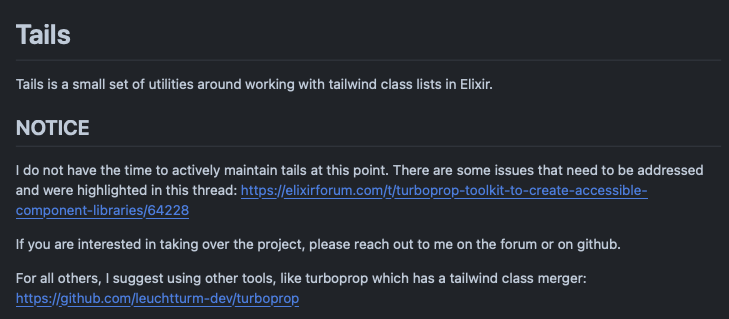Hey all!
There’s been a lot of conversation lately both around server/client-side interactivity and a bunch of component libraries popping up for Phoenix. That’s great - and if we’re honest, many of the components that are available for Phoenix are not fully accessible. It’s a hard problem to solve, with keyboard interaction, focus trapping, ARIA labeling and more to keep in mind.
Thankfully, it’s a mostly solved problem in the JavaScript world, with libraries like HeadlessUI, Radix and… Zag, which is a framework-agnostic library packing a bunch of state machines to build accessible components.
So I’ve gone on a mission to create some Phoenix hooks that wrap these state machines, and a handful (not nearly enough at the moment!) are ready to see the light of day.
Along the path, I realised that I want a way to easily write different variants for my components, and, given that overrides are needed, also intelligently merge Tailwind classes to avoid conflicts.
So, this small idea turned into a whole toolkit that offers accessibility-enabling hooks, a variant API and Tailwind class merging utilities.
It’s called Turboprop, it’s still extremely early with especially the hooks API probably changing a lot in the near future, but I’m excited for it, so it’s time to share it!
https://hexdocs.pm/turboprop/Turboprop.html
Here’s a bunch of examples:
Variants
@variants %{
variants: %{
variant: %{
default: "bg-primary text-primary-foreground shadow hover:bg-primary/90",
destructive: "bg-destructive text-destructive-foreground shadow-sm hover:bg-destructive/90",
outline: "border border-input bg-background shadow-sm hover:bg-accent hover:text-accent-foreground",
secondary: "bg-secondary text-secondary-foreground shadow-sm hover:bg-secondary/80",
ghost: "hover:bg-accent hover:text-accent-foreground",
link: "text-primary underline-offset-4 hover:underline",
},
size: %{
default: "h-9 px-4 py-2",
sm: "h-8 rounded-md px-3 text-xs",
lg: "h-10 rounded-md px-8",
icon: "h-9 w-9",
},
},
}
variant(@variants, variant: "destructive", size: "sm")
"bg-destructive text-destructive-foreground shadow-sm hover:bg-destructive/90 h-8 rounded-md px-3 text-xs"
Merge
merge(["px-2 py-1 bg-red hover:bg-dark-red", "p-3 bg-[#B91C1C]"])
"hover:bg-dark-red p-3 bg-[#B91C1C]"
Hooks
<div {dialog()}>
<button
class="rounded-md bg-blue-500 px-3 py-1.5 text-sm text-white shadow-sm hover:bg-blue-400 focus-visible:outline focus-visible:outline-2 focus-visible:outline-offset-2 focus-visible:outline-blue-500"
{dialog_trigger()}
>
Open dialog
</button>
<div class="absolute inset-0 w-full h-full bg-gray-200" {dialog_backdrop()}></div>
<div class="fixed inset-0 z-10 w-screen overflow-y-auto flex min-h-full items-center justify-center p-4" {dialog_positioner()}>
<div class="w-full max-w-md rounded-xl bg-white p-6 outline-0" {dialog_content()}>
<h2 class="text-base font-medium" {dialog_title()}>Dialog</h2>
<span class="mt-2 text-sm" {dialog_description()}>Welcome!</span>
<div class="mt-4">
<button
class="rounded-md bg-blue-500 px-3 py-1.5 text-sm text-white shadow-sm hover:bg-blue-400 focus-visible:outline focus-visible:outline-2 focus-visible:outline-offset-2 focus-visible:outline-blue-500"
{dialog_close_trigger()}
>
Close
</button>
</div>
</div>
</div>
</div>
I’ll be adding a bunch more hooks in the future, probably revisiting the hooks API and options, documentation is a work in progress as always… The entire thing is less than two weeks old, so it’ll be a bit before we’re reaching 1.0!
Let me know if there’s a hook you really want to see next, or if something is desperately missing in the documentation, or just let me know you’re gonna use this in your projects!
Maybe, just maybe, there’ll be a component library from me as well soon.



















